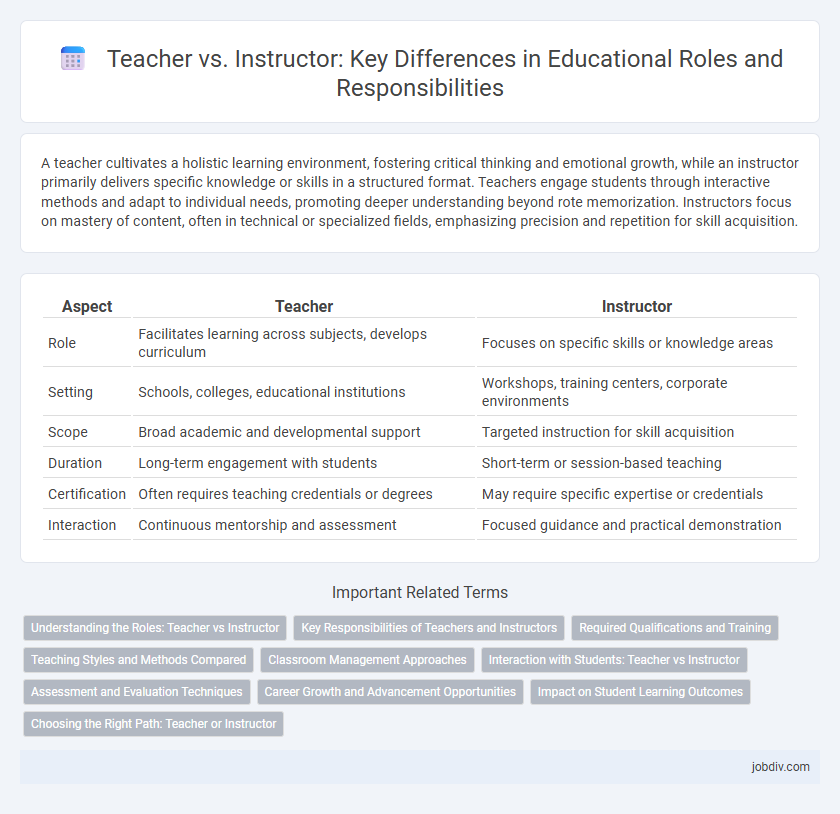A teacher cultivates a holistic learning environment, fostering critical thinking and emotional growth, while an instructor primarily delivers specific knowledge or skills in a structured format. Teachers engage students through interactive methods and adapt to individual needs, promoting deeper understanding beyond rote memorization. Instructors focus on mastery of content, often in technical or specialized fields, emphasizing precision and repetition for skill acquisition.
Table of Comparison
| Aspect | Teacher | Instructor |
|---|---|---|
| Role | Facilitates learning across subjects, develops curriculum | Focuses on specific skills or knowledge areas |
| Setting | Schools, colleges, educational institutions | Workshops, training centers, corporate environments |
| Scope | Broad academic and developmental support | Targeted instruction for skill acquisition |
| Duration | Long-term engagement with students | Short-term or session-based teaching |
| Certification | Often requires teaching credentials or degrees | May require specific expertise or credentials |
| Interaction | Continuous mentorship and assessment | Focused guidance and practical demonstration |
Understanding the Roles: Teacher vs Instructor
Teachers develop comprehensive lesson plans and assess student progress to foster long-term learning and critical thinking skills. Instructors typically focus on delivering specific skills or knowledge in a structured format, often within vocational or technical training contexts. Understanding these roles helps educational institutions tailor methods that best support student needs and learning outcomes.
Key Responsibilities of Teachers and Instructors
Teachers design and implement curriculum-based lessons while assessing student progress through evaluations and feedback. Instructors typically focus on delivering specific skills or knowledge in practical settings, often emphasizing hands-on training and real-world application. Both roles require clear communication and adaptability to meet diverse learner needs and promote effective understanding.
Required Qualifications and Training
Teachers typically require formal education credentials, such as a bachelor's degree in education and state certification, ensuring comprehensive training in pedagogy and classroom management. Instructors often need specialized expertise or professional experience in a specific subject but may not require formal teaching certification. Both roles benefit from ongoing professional development, though teachers undergo more rigorous and standardized qualification processes.
Teaching Styles and Methods Compared
Teachers typically employ a variety of teaching styles, including direct instruction, inquiry-based learning, and differentiated instruction, to address diverse student needs and learning preferences. Instructors often focus on delivering specialized content with more structured, lecture-based methods and practical demonstrations, especially in technical or vocational education. Both roles require adaptive communication skills, but teachers emphasize holistic student development, while instructors prioritize mastery of specific skills or knowledge areas.
Classroom Management Approaches
Teachers employ holistic classroom management strategies that emphasize building relationships, fostering student engagement, and creating a positive learning environment. Instructors often focus on delivering content efficiently, using structured routines and clear expectations to maintain order. Effective classroom management in education combines both relational tactics and procedural discipline to optimize student learning outcomes.
Interaction with Students: Teacher vs Instructor
Teachers foster interactive learning environments by engaging students through discussions, feedback, and personalized support, promoting critical thinking and deeper understanding. Instructors typically focus on delivering structured content and skill demonstrations with less emphasis on individual interaction, often in formal or technical settings. The level of student-teacher interaction significantly influences motivation, comprehension, and learning outcomes in diverse educational contexts.
Assessment and Evaluation Techniques
Teachers employ diverse assessment and evaluation techniques, including formative assessments, summative tests, and observational methods, to gauge student understanding and guide instructional decisions. Instructors often focus on practical skill evaluation through hands-on assessments, performance tasks, and real-time feedback, especially in vocational or specialized training settings. Both roles utilize data-driven approaches and rubrics to ensure objective measurement of learning outcomes and maintain consistent standards across educational environments.
Career Growth and Advancement Opportunities
Teachers typically follow structured career paths with opportunities for promotion to roles like department head, curriculum specialist, or school administrator, reflecting their broad educational responsibilities. Instructors, often in higher education or specialized training, may advance by gaining expertise in niche subjects, securing tenure, or moving into academic leadership positions. Both careers demand continuous professional development, but teachers benefit more from formal certifications linked to public education systems, while instructors leverage research and industry experience for career growth.
Impact on Student Learning Outcomes
Teachers often cultivate deeper student engagement through personalized lesson plans that adapt to individual learning styles, significantly enhancing comprehension and retention. Instructors typically emphasize skill acquisition and procedural knowledge, which can lead to faster mastery of specific tasks but may limit critical thinking development. Data indicates that the integrative approach used by teachers generally results in higher long-term academic achievement and improved problem-solving abilities among students.
Choosing the Right Path: Teacher or Instructor
Choosing between a teacher and an instructor depends on educational goals and context; teachers often provide comprehensive, holistic learning experiences focusing on long-term development, while instructors typically deliver specialized, skill-based training for immediate application. In academic settings, teachers design curricula, assess student progress, and foster critical thinking, whereas instructors emphasize practical techniques and hands-on learning in vocational or technical fields. Understanding these distinctions helps students and professionals select the right educational path tailored to their learning needs and career aspirations.
Teacher vs Instructor Infographic

 jobdiv.com
jobdiv.com